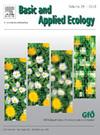膜翅目、双翅目和植物对景观同质化的脆弱性特征
IF 3.5
2区 环境科学与生态学
Q2 ECOLOGY
引用次数: 0
摘要
传粉服务目前受到土地利用变化导致的景观同质化的威胁。然而,特定物种对人为压力的反应是可变的,因此,面对景观同质化,一些物种可能表现得更好(赢家),而另一些则表现得更差(输家)。我们的主要目标是了解哪些植物和传粉者物种最容易受到这种景观干扰。为了评估这一点,我们使用了位于马略卡岛(地中海西部盆地)沿景观异质性梯度(即研究地点周围500米和1公里半径的土地覆盖层多样性)的20个研究地点的传粉者和植物丰度数据。本文收集了46种传粉昆虫(膜翅目昆虫和双翅目昆虫)和162种植物的功能性状(通过直接测量或文献资料),并沿景观异质性梯度将其丰度与其性状之间的关系联系起来。景观异质性在不同尺度上影响研究类群,双翅目的影响小于膜翅目和植物。虽然物种数量不受景观异质性的影响,但物种丰度受景观异质性的影响。景观异质性的增加有利于群居膜翅目昆虫的丰度。膜翅目地巢和洞巢的丰度随景观异质性的增加而增加,而建巢的丰度则减少。此外,随着景观异质性的增加,中小型膜翅目昆虫的丰度增加,而大型膜翅目昆虫的丰度在异质性梯度上保持稳定。景观异质性也有利于寄生性和花性双翅目昆虫的丰度。在植物方面,我们发现异质景观中颧形花的丰度也更高。了解面对景观变化的“赢家”和“输家”可能有助于预防和预测全球变化对授粉服务的影响。本文章由计算机程序翻译,如有差异,请以英文原文为准。
Traits of hymenopterans, dipterans and plants that indicate vulnerability to landscape homogenization
Pollination services are currently threatened by land-use changes that lead to landscape homogenization. However, the response of particular species to anthropogenic pressures is variable and, therefore, some species may perform better (winners) and others worse (losers) in the face of landscape homogenization. Our main objective was to understand which plant and pollinator species were the most vulnerable to this landscape disturbance. To evaluate this, we used data on pollinator and plant abundance in 20 study sites located along a gradient of landscape heterogeneity (i.e. diversity of land-cover layers at 500 m and 1 km radius surrounding the study sites) across Mallorca Island (western Mediterranean Basin). For 46 pollinator species (hymenopterans and dipterans) and 162 plant species, we collected functional traits (either by direct measurements or from literature) that reflect the ability of species to adapt to changing environments, and related their abundance to their traits along a gradient of landscape heterogeneity. Landscape heterogeneity influenced the study groups at different scales, affecting Diptera at a smaller scale than Hymenoptera and plants. Although the number of species was not influenced by landscape heterogeneity, the abundance of species was. An increase in landscape heterogeneity favored the abundance of social Hymenoptera compared to solitary ones. The abundance of Hymenoptera that nest in the ground or in cavities increased with landscape heterogeneity, while the abundance of builders decreased. Besides, increasing landscape heterogeneity enhanced the abundance of small and medium sized Hymenoptera, whereas the abundance of large Hymenoptera remained stable along the heterogeneity gradient. Landscape heterogeneity also favored the abundance of parasitoid and anthophilous Diptera. Regarding plants, we found that more heterogeneous landscapes also held a higher abundance of zygomorphic flowers. Understanding the ‘winners’ and ‘losers’ in the face of landscape changes may help prevent and anticipate the effects of global change on the pollination service.
求助全文
通过发布文献求助,成功后即可免费获取论文全文。
去求助
来源期刊

Basic and Applied Ecology
环境科学-生态学
CiteScore
6.90
自引率
5.30%
发文量
103
审稿时长
10.6 weeks
期刊介绍:
Basic and Applied Ecology provides a forum in which significant advances and ideas can be rapidly communicated to a wide audience. Basic and Applied Ecology publishes original contributions, perspectives and reviews from all areas of basic and applied ecology. Ecologists from all countries are invited to publish ecological research of international interest in its pages. There is no bias with regard to taxon or geographical area.
 求助内容:
求助内容: 应助结果提醒方式:
应助结果提醒方式:


